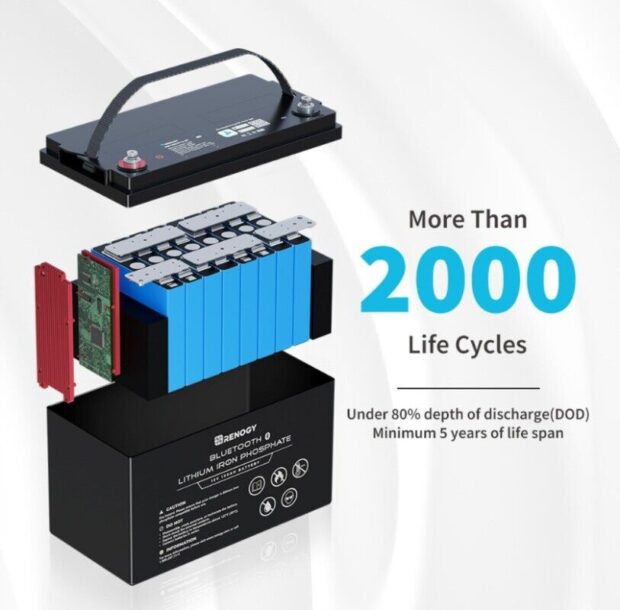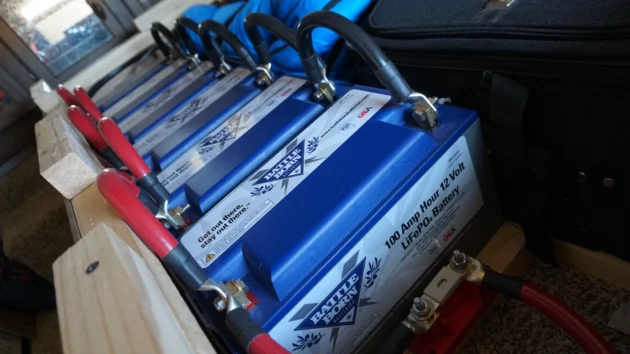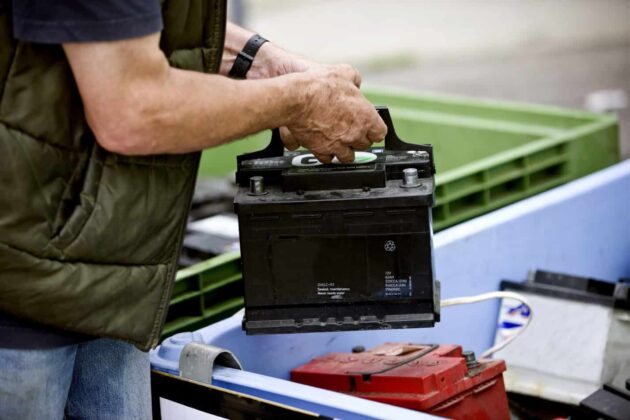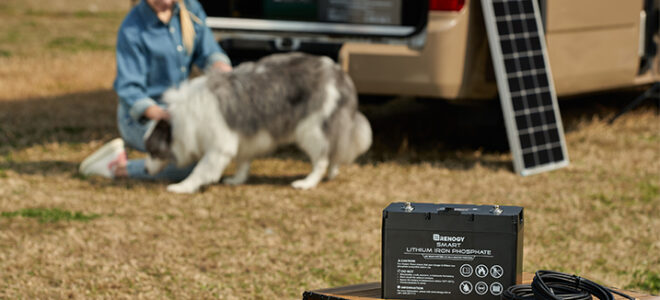I’ll skip the usual preliminaries and come straight to the point. Now, how to choose a lithium battery for your RV? Which data is important, and which battery suits whom?
The correct capacity of the lithium battery
A lot helps a lot, and of course, a larger battery capacity never actually hurts. However, more capacity also means:
- Higher cost
- More size and weight
- It may be necessary to rethink the charging technology, for example, because the solar system would otherwise be too small
As with calculating the correct size of a solar panel array, the first step with the lithium battery should be to calculate the daily energy requirements.
To do this, multiply the power consumption of each device by the number of hours you want to use it per day. In the end, you sum up all the devices, and then you know the daily energy requirement. It must be clear that this is not very precise and requires some assumptions.

Source: gumtree.com
Example of daily energy requirements:
Bulb: 10W * 4 = 40Wh
Laptop charger: 45W * 4h = 180Wh
USB charger: 15W * 8h = 120Wh
340Wh / 12.7 = 27Ah daily
The daily energy requirement is 27Ah in the example. Now you multiply the sum by the number of days that you want to bridge independently, and then you find the necessary capacity of a 12v lithium ion battery.
- With a 100Ah lithium battery, you could bridge about 3-4 days independently before you would have to charge again.
- If you want to be able to stand independently for twice as long, you need 200Ah.
- If the energy requirement is much higher (e.g. due to 2 laptops, a compressor refrigerator, and a coffee machine), more capacity is also needed.
And so you then play with your own assumptions until you find a plausible solution for your own requirements.
Of course, it is possible that the energy used can be replaced by a solar system during the day, or by the charging booster when you continue your journey. The calculation is intended to identify the limits of your own system when staying stationary and bad weather prevents the operation of solar generators.
In the end there is nothing left but to balance your own budget with the requirements for capacity and other technical factors and the installation location.
We ourselves opted for the maximum that was available in 2024: 300Ah under just one seat.
Location, size, and weight
Lithium batteries have the advantage of being compact and lightweight. Compared to a lead-acid battery, you will almost always save weight – unless you plan with a massively higher capacity.
The size varies, especially the form factors differ depending on the manufacturer. It is therefore important to decide on an installation location and then compare the possible battery models based on their dimensions. The fact that lithium batteries can also be installed sideways/turned over is useful.
The lithium batteries for under seat installation that have appeared in recent years and fit under the Ducato front seats are particularly interesting for many mobile homes.
The charging cycles

Source: doityourselfrv.com
The service life of the lithium battery based on the charging cycles is of course also important, but the information here is consistently so high that there are hardly any bad products here. Nevertheless: If you want to compare very precisely, you have to compare the cycles in connection with the DoD.
The maximum charging current
The maximum possible charging current is specified for lithium batteries. The highest possible charging current helps to recharge the battery very quickly. But whether you actually need it depends on what you actually want to load with.
A maximum charging current of 60A is specified for a Renogy, for example. In order for a solar system to be able to handle 60A, it has to be extremely large. For comparison: A typical 200Wp solar system pushes around 15A into the battery – and that with ideal solar radiation.
An alternator, on the other hand, can handle 60A, but it depends on the model whether it is beneficial to its service life to make it permanent. Charging boosters are usually sold in the 30-50A range, so the information is sufficient there too.
The maximum discharge current

Source: campersmarts.com
The maximum discharge current is now important for the current usage. And that is especially true when it comes to the operation of powerful devices. In the mobile home, these are usually devices that generate heat in some form, i.e. coffee machines, hair dryers, kettles and the like. Inverters are usually also involved.
For example, there are two indications for Renogy:
A maximum discharge current of 150A, as well a continuous discharge current of 100A.
Example: A coffee machine with 1500W means 117 amps at 12.8V. If other devices are now in operation, 150A can definitely be achieved.
If you don’t use an inverter and powerful devices, you will hardly get to these regions. The 3000w power inverter can meet almost any usage scenario.
For us, the highest possible discharge current is less important, since we primarily operate our electronics with 12V. We need the battery capacity to be able to do this for a long time, but we don’t have power peaks.
Serviceability
Some lithium batteries are sealed in plastic cases. This is of course not very easy to maintain and has little lasting effect.
US manufacturers therefore pride themselves on screwed housings that can be opened for repairs. For example, Renogy advertises with a supply of spare parts for ten years after EOL (End-of-Life).
This topic is important to us, because after all, you don’t want to have to dispose of such an expensive product as a lithium battery prematurely.
Plug & Play or build it yourself?

Source: thedyrt.com
In forums, electronics freaks accuse incompetence and ignorance when deciding on a plug & play lithium battery from a brand manufacturer.
And that’s why I would like to say one thing in advance: Yes, you can certainly assemble high-quality rechargeable batteries from individual cells that you import from China. And yes, the price is far below that of a ready-made solution. The performance of this solution is also certainly high.
But not everyone is an electronics technician or wants to become one. Because it’s not that simple:
- Which cells do you need, which ones can you trust?
- How are they wired correctly?
- Which BMS is the right one?
- Who can guarantee me that my ready-made battery will work and not just burn down the mobile home?
Yes, Electronics Engineers may be able to answer these answers. But even they then spend a lot of time researching, sourcing, building, and maybe refining.
We non-electronics engineers cannot and do not want to do that. You can’t become an expert in every field, and with batteries, I simply want a finished product that works. Where others have done the thinking for me, tested, and assured me that the solution would work for me.
Of course it costs more. Someone has to do the work, and of course a company also wants to make a profit. But that’s perfectly legitimate, and it’s the same with every product.



